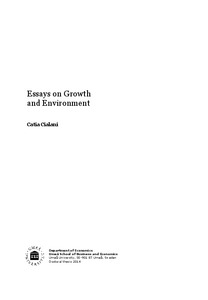Essays on growth and environment
"This thesis consists of a summary and four self-contained papers. Paper [I] Following the 1987 report by The World Commission on Environment and Development, the genuine saving has come to play a key role in the context of sustainable development, and the World Bank regularly publishes numbers...
| Main Author: | |
|---|---|
| Institution: | ETUI-European Trade Union Institute |
| Format: | TEXT |
| Language: | English |
| Published: |
Umea
2014
Umea University |
| Subjects: | |
| Online Access: | https://www.labourline.org/KENTIKA-19110634124919388169-essays-on-growth-and-environme.htm |
| Summary: | "This thesis consists of a summary and four self-contained papers. Paper [I] Following the 1987 report by The World Commission on Environment and Development, the genuine saving has come to play a key role in the context of sustainable development, and the World Bank regularly publishes numbers for genuine saving on a national basis. However, these numbers are typically calculated as if the tax system is non-distortionary. This paper presents an analogue to genuine saving in a second best economy, where the government raises revenue by means of distortionary taxation. We show how the social cost of public debt, which depends on the marginal excess burden, ought to be reflected in the genuine saving. We also illustrate by presenting calculations for Greece, Japan, Portugal, U.K., U.S. and OECD average, showing that the numbers published by the World Bank are likely to be biased and may even give incorrect information as to whether the economy is locally sustainable. Paper [II] This paper examines the relationships among per capita CO2 emissions, per capita GDP and international trade based on panel data spanning the period 1960-2008 for 150 countries. A distinction is also made between OECD and Non-OECD countries to capture the differences of this relationship between developed and developing economies. We apply panel unit root and cointegration tests, and estimate a panel error correction model. The results from the error correction model suggest that there are long-term relationships between the variables for the whole sample and for Non-OECD countries. Finally, Granger causality tests show that there is bidirectional short-term causality between per capita GDP and international trade for the whole sample and between per capita GDP and CO2 emissions for OECD countries. Paper [III] Fundamental questions in economics are why some regions are richer than others, why their growth rates differ, whether their growth rates tend to converge, and what key factors contribute to explain economic growth. This paper deals with the average income growth, net migration, and changes in unemployment rates at the municipal level in Sweden. The aim is to explore in depth the effects of possible underlying determinants with a particular focus on local policy variables. The analysis is based on a three-equation model. Our results show, among other things, that increases in the local public expenditure and income taxe rate have negative effects on subsequent income income growth. In addition, the results show conditional convergence, i.e. that the average income among the municipal residents tends to grow more rapidly in relatively poor local jurisdictions than in initially “richer” jurisdictions, conditional on the other explanatory variables. Paper [IV] This paper explores the relationship between income growth and income inequality using data at the municipal level in Sweden for the period 1992-2007. We estimate a fixed effects panel data growth model, where the within-municipality income inequality is one of the explanatory variables. Different inequality measures (Gini coefficient, top income shares, and measures of inequality in the lower and upper part of the income distribution) are examined. We find a positive and significant relationship between income growth and income inequality measured as the Gini coefficient and top income shares, respectively. In addition, while inequality in the upper part of the income distribution is positively associated with the income growth rate, inequality in the lower part of the income distribution seems to be negatively related to the income growth. Our findings also suggest that increased income inequality enhances growth more in municipalities with a high level of average income than in municipalities with a low level of average income." |
|---|---|
| Physical Description: | 26 p. Digital |

